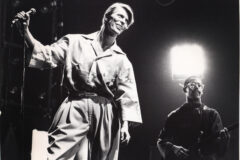Release Date: November 13, 2012
Label: Warp
In 1974, a collapsed lung forced Brian Eno away from rock stardom’s precipice soon after the release of his first solo album, Here Come the Warm Jets, leading him to explore the “Oblique Strategies” that would inform the rest of his (and innumerable others’) recorded output. The following year, he slipped in front of a speeding taxi, suffering head and back injuries. As he convalesced in a hospital bed, unable to turn up the volume on an album of harp music to prevent a rainstorm from drowning it out, he recast composer Erik Satie’s notion of “furniture music” as “ambient music.” From there, starting with Discreet Music and carrying on through a series of like-minded records, he added yet another strain to a double-helixed career: one pop- and rock-oriented, the other generative and conceptual.
And while there have been itinerant and sometimes wholly un-engaging ambient Eno albums since that initial spurt (the early 1990s’ The Shutov Assembly and Neroli are exceptions), Lux marks a full-fledged return to form. It’s also his third record for the Warp label in as many years, beginning with the by-turns churning and placid trio album Small Craft on a Milk Sea, followed by the bewildering collaboration, Drums Between the Bells, with poet Rick Holland, making this his first true solo album since 2005’s Another Day on Earth. And while its two immediate predecessors found Eno forging on into unknown terrain, this one leapfrogs back to the shimmering heights (or are they flats?) of the epochal ambient albums he made in the mid-’70s.
Stemming from the same sessions and processes that led to his sound installation currently reverberating through the Great Gallery of the Palace of Venaria in Turin, Italy, Lux offers up four just-under-20-minute tracks: a latticework of piano, e-bowed guitar, keyboards, and strings that all hang like an Alexander Calder mobile, establishing relationships, then drifting further or nearer, each of the movements nearly impossible to differentiate or distinguish. But with ambient music, that’s never quite the point.
There’s the gentlest upheaval of orchestral strings somewhere amid “Lux 2,” a descending figure on piano some 40 minutes in that recalls the icy, static chords that underpinned Music for Airports. At other times, Lux recalls the slightly cloudy drift of something like 1986’s Thursday Afternoon (itself originally a video installation from an art gallery). The whole thing is pretty, if a bit mild, suggesting not quite another green world, but something ideal for — as its cover art suggests — watching autumnal leaves turn.





